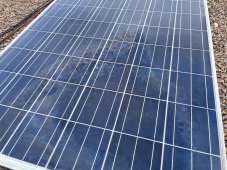I'll try washing it. When I hook 'em up I'll take a measurement on the amperage to see it affects anything.
I paid $42 each for these Santan panels about a year ago. Trucking from AZ to Las Vegas was $210 for the pallet. Still a pretty good deal. The top panel on the pallet was smashed. You can tell the trucking company stacked something else on top of it because the shattered glass had a rectangular shape to it. Santan took care of it pretty quickly.
By the way, for those of you who have purchased panels from Santan before. Which do you think is better, the cracked vinyl or the snail trails? Seems to me that the snail trails would likely fail sooner than the cracked vinyl.
Neither have any measurable effect on yield
The backing is for airborne debris, think sandstorm and the abrasive effect on an object. The back of the panel already has an encapsulation layer which seals and insulates. If you roof mounting panels, the missing vinyl means nothing, if your panels are ground mount, a coating of Henry's roof coating will do just fine.
On snail trails, cells are completely redundant in the flow of current, you can crack cells and it still produces the same current, from an energy production view it's unlikely anyone could even measure yield differences in the field. Maybe with a light table and calibrated wmsq source something could be noticed, but in the environment, irradiance, temperature as so variable, it would be impossible to measure.
The reason these are being sold is the power companies got to replace under warranty at manufactures expense, so literally the panels are close to just given away to places like Santan and others as disposable is more costly.
I built a 3.3kw array with used Enphase M250's for under 1K with the same panels and ran it for a year. Sold off the panels to a semi-local offgrid owner at cost and then got my current 395W half cell mono's from Santan for ~20 cents a watt, this is a 11kw system, running now 2+ years with zero issues.




